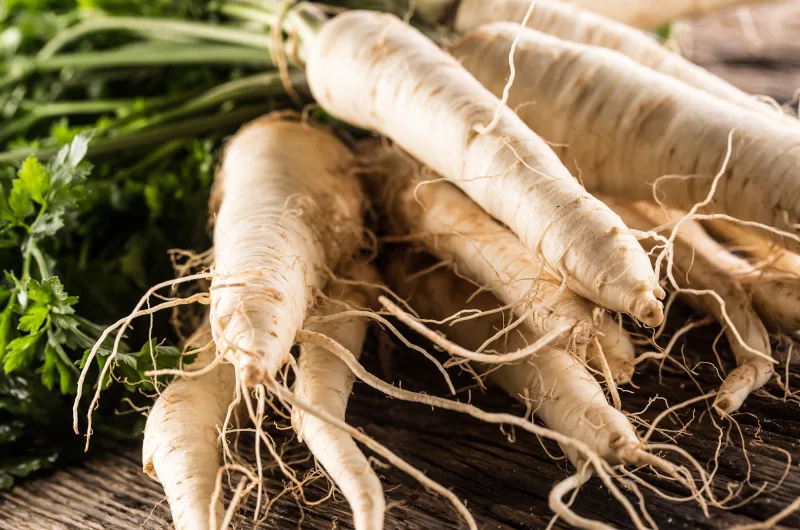How To Grow Parsnips
Parsnips, with their sweet and earthy flavour, are a wonderful addition to any kitchen, whether roasted, mashed (especially when combined with carrots) or in soups. These versatile root vegetables are not only delicious but also relatively easy to grow in your own UK garden. Whether you’re a seasoned gardener or a beginner, cultivating parsnips can be a rewarding experience. In this article, we will provide you with a comprehensive guide on how to grow parsnips, from selecting the right variety to enjoying a bountiful harvest.
Choosing the Right Parsnip Variety:
When it comes to selecting parsnip varieties for your UK garden, consider the climate and length of the growing season in your area. Some popular UK parsnip varieties include ‘Hollow Crown’ known for its sweet flavour and long roots, ‘Gladiator‘ for its reliable yields, and ‘Tender and True‘ which is excellent for culinary purposes.
Parsnip seeds have a relatively short shelf life and take 2-4 weeks to germinate. For this reason, we’d recommend starting with fresh seed every 1-2 seasons. There’s nothing worse than sowing a row of seeds, then waiting patiently, only to find that nothing appears.
Preparing the Soil:
Parsnips thrive in deep, well-drained soil. Start by clearing the planting area of any weeds or debris. Ideally, choose a spot with full sun exposure. Loosen the soil using a garden fork or tiller to a depth of at least 30 cm, removing any rocks or obstructions. Ideally, incorporate well rotted manure or compost into the soil in autumn to help improve soil fertility. Don’t add anything in spring before planting, as this can result in the roots forking.
Sowing Parsnip Seeds:
Parsnips are best grown from seeds as they do not transplant well. Sow the seeds directly into the ground from late winter to early spring. Soak the seeds in water for a few hours before sowing to help with germination. Create shallow furrows in the prepared soil, about 1 cm deep and around 30 cm apart. Sow the seeds thinly along the furrow, spacing them approximately 2 cm apart, and cover them gently with fine soil.
Watering and Thinning:
After sowing the parsnip seeds, ensure the soil remains consistently moist throughout the germination period. Be patient, as parsnip seeds can take up to four weeks to sprout. Once the seedlings have emerged, thin them out to provide enough space for each parsnip to grow. Aim for a final spacing of around 10-15 cm between plants.
Providing Care and Maintenance:
To promote healthy growth, keep the area around your parsnips free from weeds, which can compete for nutrients and water. Regularly hand-weed the area, being careful not to disturb the delicate parsnip roots. Mulching the soil with organic matter or straw can help retain moisture, regulate soil temperature, and suppress weed growth.
Protecting Against Pests:
Parsnips are generally resilient against pests, but they may occasionally attract carrot fly and other insects. They’re also a bit of a magnet for rabbits, who seem drawn to the scent of the foliage in the early season, when there’s little fresh green foliage around. Consider using fine netting or horticultural fleece to create a physical barrier and protect your crop. Additionally, companion planting with aromatic herbs such as sage or planting onions nearby can help deter pests.
Harvesting Your Parsnips:
Parsnips require a long growing season and are typically ready for harvest from late autumn to early winter. Leave the parsnips in the ground as long as possible to allow their flavour to fully develop. When ready, gently loosen the soil around the parsnips with a fork and lift them carefully to avoid any damage. Remember, parsnips taste sweeter after exposure to colder temperatures, so they can be left in the ground even after the first frost. We’d also recommend leaving a few in the ground for harvesting on Christmas Eve. Roasted freshly harvested roots make a wonderful addition to your Christmas dinner!
Growing parsnips in your UK garden is a rewarding endeavor that will provide you with a delicious and nutritious addition to your meals. By choosing the right variety, preparing the soil, sowing the seeds, and providing proper care, you can enjoy a successful harvest of flavourful parsnips. So, roll up your sleeves, embrace the joys of gardening, and look forward to the satisfaction of harvesting your very own homegrown parsnips.



